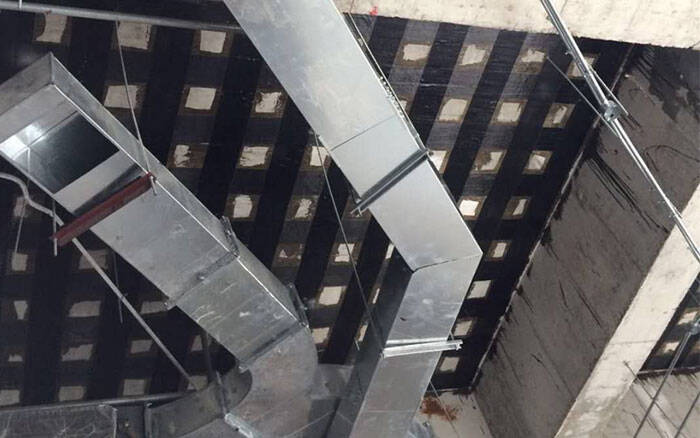Carbon fiber fabric for seismic strengthening
Bonded carbon fiber fabric for slab and wall strengthening
The original building was put into use in 1991, with an area of about 3478m2. The main body is a four story brick concrete structure. In this project, the original building is seismic strengthened, the internal and external walls are strengthened by plastering cement mortar and pasting carbon fiber, and the roof is strengthened by carbon fiber fabric.

The original building was put into use in 1991, with an area of about 3478m2. The main body is a four story brick concrete structure. In this project, the original building is seismic strengthened, the internal and external walls are strengthened by plastering cement mortar and pasting carbon fiber fabric, and the roof is strengthened by carbon fiber fabric.
It is necessary to use M10 cement mortar inside and outside the brick walls to be reinforced.
In addition, the carbon fiber fabric is adhered to the cement mortar wall and the model is 200g/m2. Or 300g/m2
Carbon fiber reinforced fabric 200g/m2 for precast slab.
Main material:
Carbon fiber fabriv
Carbon fiber adhesive
Chemical anchor epoxy
M10 mortar
Construction of CFRP reinforcement
1. surface treatment
1) Remove the deteriorated concrete such as spalling, loosening, honeycomb and corrosion on the surface of the strengthened members, expose the concrete structure layer, and repair the surface with repair materials. Because this project is a prefabricated floor, this part of the base material condition is better, and local treatment is carried out according to the site situation.
2) According to the design requirements of the crack grouting or sealing treatment, according to the site conditions, if the concrete quality is good, no cracks and other phenomena, this part of the work can be omitted;
3) The surface of the concrete to be pasted should be polished flat, remove the surface slurry, oil stains and other impurities, until fully exposed to the new surface of the concrete structure, corner paste should be conducted and polished into a circular arc, the arc radius should not be less than 20 mm;
4) the concrete surface should be cleaned and kept dry.
2. leveling treatment
1) prepare leveling material according to the process regulations provided by the product manufacturer;
2) To fill the concave part of concrete surface with leveling material, there should be no edges and corners; to repair the corner with leveling material into a smooth arc, the radius of the arc should not be less than 20 mm;
3) when the surface of the leveling material is touched and dried, the construction of the next working procedure shall be carried out as soon as possible.
3. sticking carbon fiber cloth fabric
1) carbon fiber fabric should be cut according to the size required by the design.
2) prepare impregnated resin according to the process regulations provided by the product manufacturer, and apply evenly to the bonding part.
3) Carbon fiber fabric is pressed on the position to be pasted by hand, and the special roller is used to roll along the fiber direction for many times to extrude bubbles, so that the impregnated resin is fully immersed in the carbon fiber cloth, and the carbon fiber fabric can not be damaged during rolling.
4) the curing of adhesives can be done at normal temperature. For sticking carbon fiber fabric within 24 hours, no disturbance is allowed.
4. on-site product protection measures
The finished products on site should be protected during curing period. Attention should be paid to dust prevention, water proofing and prevention of human destruction. At the construction site, special personnel should be sent on duty to prevent human destruction and responsibility should be implemented to individuals.